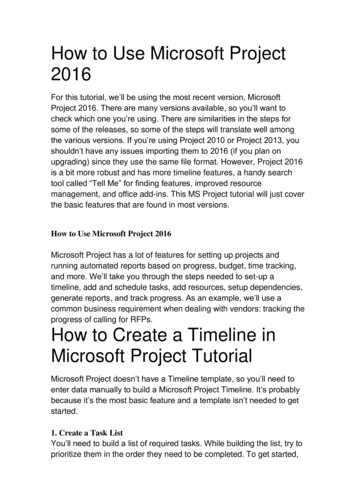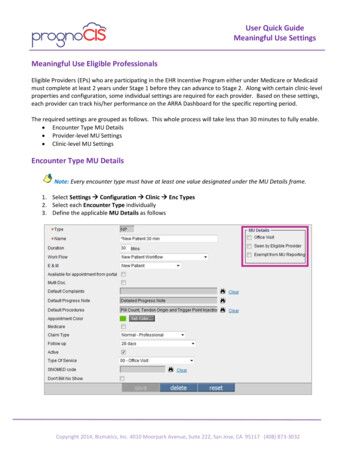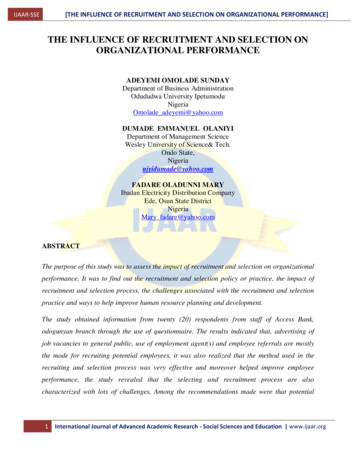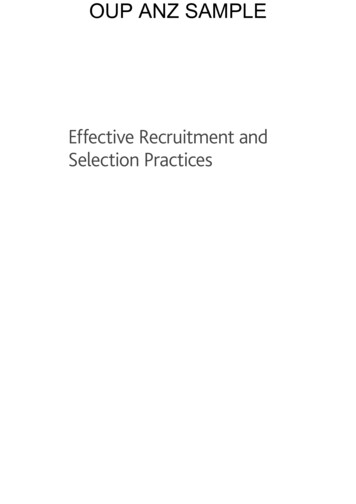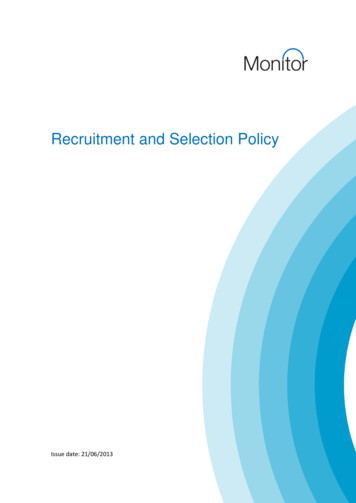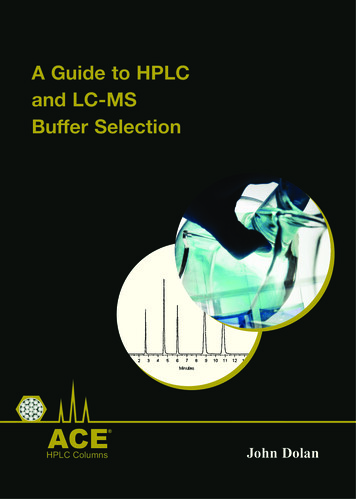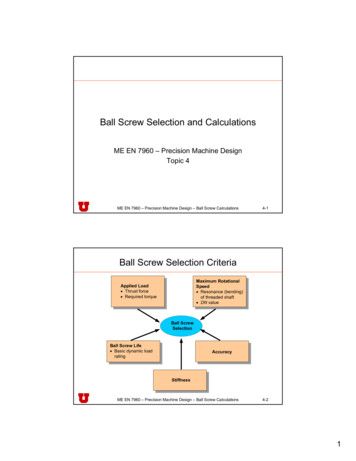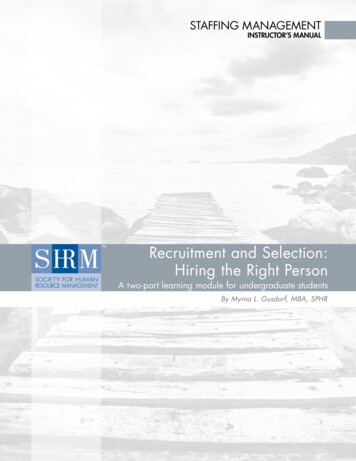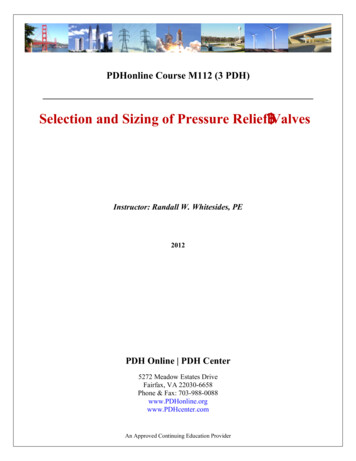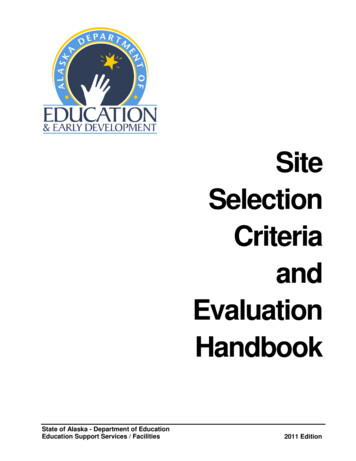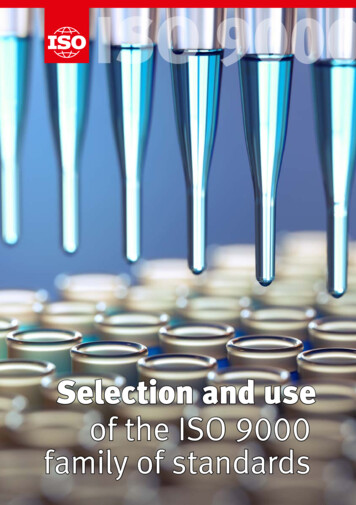
Transcription
ISO 9000Selection and useof the ISO 9000family of standards
Selection and useof the ISO 9000 family of standardsThe ISO 9000 family of international quality management standards and guidelineshas earned a global reputation as a basisfor establishing effective and efficient quality management systems.The need for International Standards isvery important as more organizationsoperate in the global economy by selling orbuying products and services from sourcesoutside their domestic market.This brochure providesyou with : This publication was developed by ISO/TC 176, the ISO technicalcommittee specialized in qualitymanagement. For further informationon ISO 9001 and related standards,visit https://committee.iso.org/tc176sc2. An overview ofthe ISO 9000 family ofcore standardsA step-by-step processto implement a qualitymanagement systemExamples of typical applications of the standards,andA bibliography listing theISO 9000 family of standardsThis brochure has been developed by ISOtechnical committee ISO/TC 176, Qualitymanagement and quality assurance, whichis responsible for developing and maintaining the ISO 9000 family. Supportingguideline standards and other documentsare developed and updated on a continualbasis to meet the needs and expectationsof users and the market itself.The brochure provides a general perspective on the ISO 9000 family and explainshow you can use it to improve your qualitymanagement system. It gives an overviewof the standards and demonstrates how,collectively, they form a basis for continualimprovement and business excellence.ISO 9000 family 1
The ISO 9000 familyCore standardsISO 9001 specifies the basic requirements for a qualityISO 9000, Quality management systems –management system that an organization must fulfil toFundamentals and vocabulary, providesdemonstrate its ability to consistently provide productsthe fundamental concepts, principles andand services that enhance customer satisfaction andvocabulary used in the entire ISO 9000meet applicable statutory and regulatory requirements.family of standards. It sets the stage forThe standard can be used for certification/registrationunderstanding the basic elements of qual-and contractual purposes by organizations seeking rec-ity management as described in the ISOognition of their quality management system. ISO 9001standards. ISO 9000 introduces users tohas been organized in a user-friendly format with termsthe seven quality management principlesthat are easily recognized by all business sectors.as well as the use of the process approachYou will obtain the greatest value by using the entireto achieve continual improvement.family of standards in an integrated manner. It is highlyISO 9001, Quality management systemsrecommended that you use ISO 9000 to become familiar– Requirements, is used when you arewith the fundamental concepts, principles and norma-seeking to establish a quality manage-tive vocabulary of a quality management system beforement system that provides confidenceyou adopt ISO 9001 to achieve an effective level of per-in your organization’s ability to provideformance. The practices described in ISO 9004 may thenproducts that fulfil customer needs andbe implemented to make your quality managementexpectations.system more efficient in achieving your business goalsISO 9001 specifies the requirementsand objectives.against which your quality managementISO 9001 and ISO 9004 have been written to enable yousystem can be certified by an externalto relate them to other management systems (e.g. envi-body. The standard recognizes that theronmental), or to sector-specific requirements (such asterm “ products and services ” applies toISO/TS 16949 in the automotive industry, AS9100/EN 9100services, processed material, hardware andin aviation, space and defence, TL 9000 in telecommuni-software intended for your customer.cations) and to assist you in gaining recognition throughnational or regional award programmes.2 ISO 9000 familyISO 9000 family 3
ISO 9001 defines what you should do to consistentlyprovide product that meets customer expectations andapplicable statutory and regulatory requirements. Inaddition, you will seek to enhance customer satisfactionby continual improvement of your quality managementsystem.ISO standards apply a process approach. Processes arerecognized as consisting of one or more linked activitiesthat require resources and must be managed to achievepredetermined output. The output of one process maydirectly form the input to the next process and the finalproduct is often the result of a network or system ofprocesses.Further guidance can also be found in the ISO 9001:2015There are seven clauses in the standard specifying activi-introduction and support package prepared by sub-ties that need to be considered when you implementcommittee SC 2, Quality systems, of ISO/TC 176, whichyour system :provides further guidance on : Context of the organization Summary of changes Leadership Implementation Planning Documentation requirements Support Process approach Operation Risk-based thinking Performance evaluation Frequently asked questions (FAQs) Improvement Management of changeThe requirements in all sections of ISO 9001 are applicable. An organization will need to provide justification for Correlation between ISO 9001:2008 andISO 9001:2015any requirement of this International Standard that theISO/TC 176 maintains a database of approved interpreta-organization determines is not applicable to the scopetions of the ISO 9001 standard.of its quality management system. A manual, or otherISO 9004, Managing for the sustained success of andocumented information, will demonstrate how youorganization – A quality management approach, is usedmeet the ISO 9001 requirements in your organization.to extend the benefits obtained from ISO 9001 to all parties that are interested in, or affected by, your operations.4 ISO 9000 familyISO 9000 family 5
Interested parties include your employees, owners, suppliers, partners and society in general.ISO 9004 gives guidance on a wider range of objectivesof a quality management system than ISO 9001, particularly in managing for the long-term success of anorganization. ISO 9004 is recommended as a guide forImplementing and maintaininga quality management systembased on ISO 9001organizations whose top management wishes to extendthe benefits of ISO 9001 in pursuit of systematic andcontinual improvement of the organization’s overallperformance. However, it is not intended for certificationor contractual purposes.ISO 19011, Guidelines for auditing management systems,covers the area of auditing of quality management systems and environmental management systems. It provides guidance on audit programmes, the conduct ofinternal or external audits, and information on auditorcompetence.ISO 19011 provides an overview of how an audit pro-gramme should operate and how management systemaudits should take place. Effective audits ensure thatan implemented QMS meets the requirements specifiedin ISO 9001.The nature of your organization and your specificneeds will determine how you apply these standardsto achieve your goals and objectives. Useful hints andtips for conducting audits have been developed by theISO 9001 Auditing Practices Group. Information onthird-party auditing has also been compiled by the jointISO-IAF (International Accreditation Forum) Accredita-tion Auditing Practices Group.The implementation process is important in achieving the full benefits of the quality management system (QMS). Most new users will obtain measurablepayback early in the process. A QMS is a dynamic system that evolves over timethrough periods of improvement. It is necessary to determine activities that alreadyexist and their suitability within the context of theorganization. A formal QMS provides a framework for planning,executing, monitoring and improving the performance of quality management activities. In developing the QMS, the fundamental conceptsand principles given in ISO 9000 can provide valuable guidance. A successful QMS must fit your organization. Thefollowing seven steps may be helpful as guidance :6 ISO 9000 familyISO 9000 family 7
1238 ISO 9000 familyEngage top management to Agree on why to implement a QMS Determine the context of the organization, strategic objectives and businessprocesses Determine customer and interested parties’ needs and expectations Understand the quality managementprinciples described in ISO 9000 Review the implication of risk-basedthinking Define the objectives of the organization Describe the scope of the QMS Define the policy Determine quality objectivesIdentify key processes Identify the processes needed to deliverproducts and services Understand ISO 9001 requirements Determine the risks and opportunitiesapplicable to the processesPlan your QMS Identify the gaps in the existing system compared to QMS requirements Identify the process controls needed Define the working environmentneeded Define the skills and facilities needed4567Document your QMS Document the processes, activities andcontrols needed Prepare the documented information(procedures and records) required by thestandard and according to your needs Ensure the QMS conforms toISO 9001 requirementsImplement your QMS Manage the processes Control monitoring and measuringequipment Train employees Verify effective operation of processesManage your QMS Monitor and measure performanceAudit process effectivenessFocus on customer satisfactionManage system and operational changePerform management reviewImprove your QMS Seek third-party certification/registrationof the QMS Strive for improvement with reference toISO 9004 Consider implementing business excellence models in company operationsISO 9000 family 9
Process modelof ISO 9001The Plan-Do-Check-Act (PDCA) cyclecan be applied to all processes and tothe quality management system as awhole. The figure below illustrates howClauses 4 to 10 can be grouped in relation to the PDCA cycle.Quality management system44Organizationand its context7, 8Support andorganizationPlanDoCustomer ipAct9PerformanceevaluationCheckResults of the QMSProducts and services10Access andexpectationof interested partiesImprovement4 clause numberRepresentation of the structure of this International Standard in the PDCA cycle.10 ISO 9000 familyISO 9000 family 11
ExamplesUsing the ISO 9000 family of standardsExample 2A local government in a developing country wantedto improve its services and enhance community confidence. It turned to ISO 9000 and ISO 18091 to establisha quality management system. The guidance given inISO 9004 helped develop training modules in processmanagement, explaining how each person contributesto achieving reliable services. Similary, the engineeringdepartment used the guidelines contained in ISO 10006for managing its public works programmes. ISO 10005served as a basis to create training courses in the use ofquality plans, enabling a wide variety of organizationsto engage in construction and maintenance contracts,whether or not they maintained a formal QMS.Example 1A metal parts manufacturer, recognizing the need to demonstrate its capability to produceconsistent quality product, had implemented a QMS based on ISO 9001:2008 and wasnow required to become registered to ISO 9001:2015. It reviewed the matrix showingthe correlation between ISO 9001:2008 and ISO 9001:2015 (see www.iso.org/tc176/sc02/public) and saw that the basic requirements of its existing QMS could be retained.Annexes A and B of ISO 9001:2015 provided additional information when performing agap analysis of its existing QMS. The manufacturer decided to retain the documentedinformation in its quality manual and the structure of the QMS after addressing theimplication of risk-based thinking. Later, in order to bid on the supply of parts to a majorautomotive company, it upgraded its quality system to meet the automotive sector-specificrequirements of ISO/TS 16949.12 ISO 9000 familyISO 9000 family 13
Example 3An electrical appliance manufacturer had a well- established company culture of continual improvementand effective production control. The managementdecided to improve the company’s development processes and implement ISO 9001 to obtain certificationfor commercial purposes. The company used ISO 9004to guide its improvement processes and ISO 10006 todevelop a project management plan for the developmentproject. Regulatory agencies demanded that productsbe designed and packaged recognizing the end-of-lifedisposition of products and packaging. The companyadopted risk-based thinking and used ISO 10005 todevelop a quality plan identifying the sequence of pro-Example 4cesses from concept to disposal of the product.A large chemical processing company was required byits major customers to gain certification to ISO 9001 andto be environmentally friendly. To address these issues,the company leadership planned a comprehensivemanagement strategy linking its QMS and an ISO 14001environmental management system (EMS). A thoroughreview of the business processes indicated that all elements of ISO 9001 were applicable to its QMS. The company used ISO/TR 10013 to guide the development of anyrequired documented information for its QMS and EMSin its various production divisions, ISO 10015 for guidance in the preparation of training plans for realizing therequired competence of its employees, and ISO 19011 forauditing both the QMS and EMS. Management achievedadditional benefits and continual improvements usingISO 9000 and ISO 9004.14 ISO 9000 familyISO 9000 family 15
Example 5Example 6A firm of international lawyers wantedA bank decided to implement a quality managementto improve its client management pro-system limited to the scope of its online banking ser-cesses using the
ISO 9001 defines what you should do to consistently provide product that meets customer expectations and applicable statutory and regulatory requirements. In addition, you will seek to enhance customer satisfaction by continual improvement of your quality management system. ISO standards apply a process approach. Processes are


